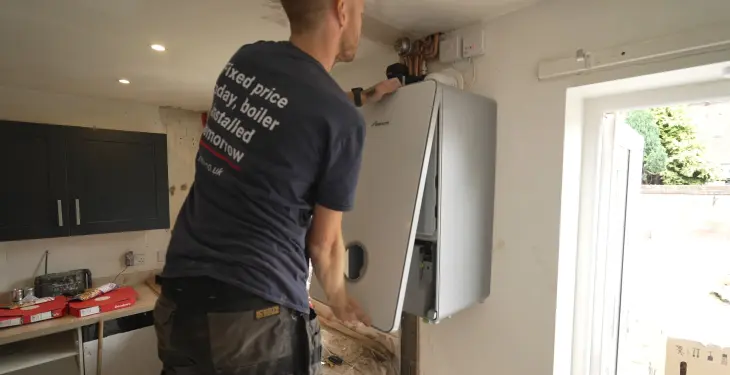

Written by Stephen Day
Gas Safe Engineer
Updated: 30th May, 2025
Understanding how to properly drain the system is vital for homeowners and DIY enthusiasts alike, as it can save costs and promote the longevity of the heating system.
Get a new boiler quote, save up to £550 per year (0% APR available).
Draining a central heating system is a task that might be undertaken during routine maintenance, when repairing or replacing components such as radiators, or when adding substances to improve performance, like inhibitors.
It's important to approach this task methodically to ensure it's done efficiently and without causing damage.
Understanding how to properly drain the system is vital for homeowners and DIY enthusiasts alike, as it can save costs and promote the longevity of the heating system.
Safety is paramount when performing any work on a heating system. Before proceeding, one should turn off the boiler and any electrical pumps, allow the system to cool down, and prepare adequate tools and safety equipment. It's also prudent to know the location of the drainage valve and to have a strategy for disposing of the water.
While the practical steps of draining a system are straightforward, attention to detail can mean the difference between an easy job and a problematic one. After draining, care must be taken to properly clean and refill the system according to manufacturer specifications, which generally includes venting air from radiators and checking for leaks.
Get a quote in 60 seconds, fitted as fast as next day!
0% APR finance available.
Before delving into our easy tip follow, in depth guide on How to Drain Central Heating System, it’s important to know in some cases DIY fixes are not safe.
You are not confident in your ability to clearly follow a step-by-step guide.
The system shows signs of significant damage.
You lack proper safety equipment and tools.
If any of the above applies, it is advisable to seek assistance from a professional heating engineer.
Ensuring safety is paramount when draining your central heating system. This involves careful preparation and an understanding of your heating system's components.
The first step in the preparation process is to correctly identify key components of your heating system. This includes locating the boiler, radiators, and the drain-off valve. Familiarise yourself with these parts as they are critical in the draining process.
Before commencing, gather necessary tools:
Adjustable spanner or wrench
Radiator bleed key
Hose for drainage
Container or bucket for initial water discharge
Towels or cloth for spill management
Assemble your equipment near the drain-off valve for efficient access.
Before attempting to drain, it is essential to turn off your central heating system. This includes shutting down the power supply to the boiler and allowing the hot water to cool down to avoid the risk of scalding.
Before initiating the process of draining your central heating system, ensure that the heating is turned off and the system has cooled down. This safety measure prevents any accidents related to hot water. The following steps provide a detailed guide to effectively and safely drain the system.
Identify the lowest point in the system where the drain valve is located, usually at the radiator downstairs. Securely attach a hosepipe to the drain valve, making certain it's fitted tightly with an adjustable spanner to prevent leakage. Run the opposite end of the hose to an outside drain or a sturdy bucket if closer.
Proceed upstairs and begin with the highest radiators, opening their bleed valves with a radiator key or flathead screwdriver. This action allows air into the system, which replaces the water being drained, thus hastening the drainage process.
Methodically work your way downstairs, moving from the topmost radiator to those on the lower floors. This ordered approach ensures air pushes the water steadily out of each radiator. Close each bleed valve after successfully confirming the adjacent radiator begins to drain, ensuring a systematic and complete flush of the system.
Once water has ceased flowing from the open drain valve, it's crucial to check each radiator. The lack of residual water signifies all air has been purged and the system completely drained. If any radiator remains full, open the bleed valve to release trapped water and air.
By adhering to these explicit instructions, one can conduct maintenance effectively, ensuring all elements, from the bleed valves to the hosepipe's securement, work harmoniously to achieve a thoroughly drained central heating system.
Maintaining the efficiency of a central heating system hinges on regular removal of internal sludge and limescale, followed by the addition of protective substances. Now, let's explore the crucial stages of flushing out sediment and introducing an inhibitor.
After draining the system, it is vital to flush it to eliminate accumulated sludge and sediment. Initially, connect a hose to the drain valve ideally situated at the lowest point - which will help guide the debris out. Energise the circulation pump and open the system's valves to forcefully expel the unclean water. This flushing process might require repetition, with the added step of strategically opening and closing individual radiators to ensure a comprehensive cleanse.
Key Steps for Flushing:
Connect a hose to the drainage valve.
Activate the pump to circulate the water.
Sequentially open and close radiators to dislodge sediment.
A successful flush results in clear water exiting the system, signifying the removal of most of the sediment and limescale. When done accurately, it improves thermal efficiency and extends the system’s longevity.
Once the system water runs clear, refilling can commence. Prior to this step, introducing a chemical inhibitor is essential to protect against future corrosion and scale accumulation. It does so by forming a protective barrier on the interior surfaces. The inhibitor should be poured into a radiator or via a dedicated inlet, depending on the system's design.
Procedure for Adding Inhibitor:
Close all valves and drain points.
Begin refilling the system.
Introduce the correct amount of inhibitor as per manufacturer guidelines.
While refilling, attentively watch the pressure gauge to prevent overpressurisation, which could cause damage or leaks. After topping up the system, bleeding the radiators is necessary to remove any entrapped air, ensuring even heating across all units. Regular checks on the inhibitor level and reapplication per manufacturer recommendation will help keep the system operating at peak efficiency.
Once the central heating system is drained, it must be correctly refilled and checked to ensure there are no leaks and it is operating efficiently. These procedures restore normal function and preserve the longevity of your heating setup.
Repressurising the boiler involves restoring the water pressure within the heating system. First, locate the boiler's filling loop, typically found below the unit. Open the valves slowly to allow water to flow in, all the while keeping an eye on the pressure gauge. This process must be done gently to avoid any sudden pressure changes which might damage the boiler. The correct pressure is usually around 1-1.5 bar, though you should consult the boiler manual for the manufacturer's recommended pressure level.
Once you've repressurised the system, it's likely air has entered, necessitating the bleeding of radiators. Start with the radiators at the lowest level of your property, working your way upwards. At each radiator, use a radiator key to turn the bleed valve counterclockwise until water, instead of air, escapes. This procedure removes airlocks and promotes efficient heating throughout the home.
After bleeding the radiators, run the heating to check for any leaks. It's essential to examine all pipeline connections and the radiators themselves, especially along the valve joins. Should you discover any leaks or experience boiler issues, it may be time to call in a plumber for boiler repair work. Continuous monitoring over the next few days will help catch any slow leaks at radiators or heating pipes that may not have been immediately apparent.
Routine maintenance of a central heating system is paramount to ensure its longevity and optimal performance. A well-maintained system not only runs more efficiently but may also prevent costly breakdowns. Homeowners can undertake some fundamental precautions to aid in the prevention of issues.
Weekly checks should include monitoring the pressure gauge and searching for any visible leaks. If the pressure drops consistently, there may be a small leak within the system. During these inspections, confirming that all radiator valves are free from corrosion and functioning correctly is advisable.
Annual servicing by a professional is essential. They will meticulously inspect the boiler and its components, clean critical parts, and conduct a flue gas analysis. This ensures the system operates safely and at peak efficiency. Record servicing dates; most manufacturers recommend servicing every 12 months to maintain the warranty.
To mitigate limescale and corrosion, adding a chemical inhibitor is a useful preventative step. This substance maintains the internal cleanliness of the heating system, and it's best applied by a professional who can gauge the correct quantity for the system's capacity.
While power flushing is not required annually, it plays a critical role in system maintenance. This process clears sludge and debris from pipes and radiators, which might otherwise hinder the system's efficiency.
Lastly, homeowners should familiarise themselves with the system's operation manual. It often contains vital information specific to their model, which could be beneficial for understanding and maintaining their setup.
By adhering to these preventative measures, one can assure the durability and optimum functionality of their central heating system.
When dealing with the complexities of a central heating system, knowing when to seek professional help isn’t always straightforward. Safety is paramount; hence, if at any stage the process seems beyond one's skill set, one should contact a Gas Safe registered heating engineer.
Particularly, the presence of a gas supply necessitates caution. If one smells gas or suspects a leak during any stage of draining the heating system, it's crucial to cease all work. Immediately contact a Gas Safe registered engineer or the National Gas Emergency Service.
Moreover, a Gas Safe heating engineer should be called if there are issues with the boiler itself, especially if it involves gas connections or combustion. Any tampering with gas appliances by an unqualified person is not only dangerous but also illegal.
There are specific signs that indicate the need for professional help. These might include:
Water still entering the system after the supply has been supposedly isolated.
Unusual noises emanating from the boiler or radiators, potentially signalling trapped air or other issues.
Radiators not heating properly even after the system has been bled and refilled.
In situations where the heating system hasn't been drained for years, sediment might have accumulated. This scenario might warrant a power flush, a job suited for professionals with the right equipment to thoroughly cleanse the system.
Lastly, should any doubts arise concerning the competency to carry out the draining process, it's safer to err on the side of caution. One should engage the services of a certified heating engineer to ensure the job is done efficiently and safely, maintaining the system's integrity and residents' well-being.
Determining whether your central heating system requires a new boiler can be a daunting task. Here are some key indicators that suggest it might be time to invest in a new unit.
Firstly, age factors in heavily. The average lifespan of a boiler is typically between 10 to 15 years. If your boiler is approaching or has surpassed this age range, its efficiency could be significantly reduced.
One must also consider frequent breakdowns. Occasional issues might not warrant a complete replacement, but if breakdowns become a regular occurrence, the cumulative cost of repairs and potential inefficiencies in heating might make a new boiler a more cost-effective solution.
Energy bills can give you a clue, too. An increase in energy bills could imply that the boiler is working harder to provide the same amount of heat, thereby using more energy and driving up costs. This is often a sign that the system's efficiency has dropped.
Moreover, the presence of strange noises like bangs, whistles, or gurgles could indicate that something internally, such as the heat exchanger, is faulty. Such problems suggest that the boiler is struggling to operate effectively.
Lastly, observe if the boiler flame is burning yellow instead of blue. This could indicate incomplete combustion, a serious issue that could not only affect the boiler's efficiency but also pose safety risks.
When considering these signs, consult with a certified heating engineer. They can provide a professional assessment and recommend whether a repair might suffice or if a new boiler would be a more prudent choice.
Get a quote in 60 seconds, fitted as fast as next day!
0% APR finance available.
Boilers can be a daunting purchase for many people as they’re an appliance with a lot of responsibility, providing heat for you and your family is something you want to get right. Boilers aren’t exactly a quickly disposable item either, potentially lasting you a decade.
Boiler costs can be split into two segments: the first is the actual boiler itself (unit price), and the second is the cost of the boiler being installed (set up) in your property by an expert engineer.
Here at iHeat, we want to remove all of this undue stress and make the decision making process of upgrading to a new central heating system, as easy as possible.
Boiler costs can vary depending on a number of factors including their brand, model, fuel, output, warranty, labour and installation type. Typically a new boiler will cost between £1,845 and £3,500, below is a list of average boiler installations offered by iHeat (guide only).
Installation Type | Price (inc VAT) | |
Combi to combi swap | £1,845 | |
System to combi conversion | £2,499 | |
New boiler install | £2,899 | |
Back boiler to a combi | £3,299 | |
System to system | £1,945 |
Last updated: 30th May, 2025

Written by Stephen Day
Gas Safe Engineer at iHeat
Stephen Day is a Gas Safe registered and FGAS certified engineer with over 20 years of hands-on experience in the heating, cooling, and renewable energy industry, specialising in boiler installations, air conditioning, and heat pump systems.
LinkedInArticles by Stephen Day are reviewed by iHeat’s technical team to ensure accuracy and reliability.

22nd December, 2025
Based on data from over 7000 boiler installations completed by iHeat in the past 12 months...
 Read Article
Read Article

22nd December, 2025
Here’s a quick roundup of the best combi boilers for 2026.
 Read Article
Read Article

22nd December, 2025
When your old boiler breaks down and it comes time to replace it with a new one, it might...
 Read Article
Read Article
No obligation. Takes less than 60 seconds.